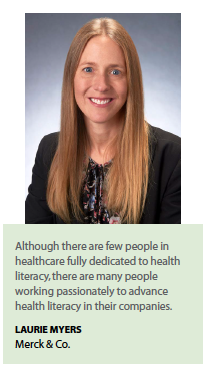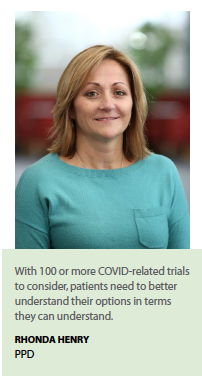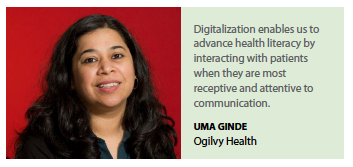Health literacy can have a significant bearing on outcomes, so helping patients understand their health and treatments is critical.
Health information is by its very nature complex. Explaining a disease or how to take a drug or a drug’s potential side effects to a patient can be difficult and can prevent patients from making informed decisions about managing their condition. Research from the U.S. Department of Health and Human Services (HHS) finds only 12% of U.S. adults have proficient health literacy and a third have difficulty with common health tasks such as following directions on a prescription label. HHS defines health literacy as the degree to which individuals have the capacity to obtain, process, and understand basic health information needed to make appropriate health decisions.
Efforts are in place across the board — from government organizations, private companies, healthcare professionals, medical schools, and public health organizations — to address health literacy challenges. For example, to address some of the digital challenges patients with low literacy have, the Office of Disease Prevention and Health Promotion (ODPHP) within HHS  has a guide to health literacy online. The guide provides practical insights into users’ experiences and suggestions on creating easy-to-use digital health tools for patients struggling with health literacy.
has a guide to health literacy online. The guide provides practical insights into users’ experiences and suggestions on creating easy-to-use digital health tools for patients struggling with health literacy.
The pharmaceutical industry has ramped up its efforts to address the health literacy challenge amid a growing recognition that there is more to health literacy than simply creating materials to satisfy a certain “grade level" requirement, says Uma Ginde, senior VP, creative director, Ogilvy Health. “The use of specific colors and graphics, iconography, and storyboard-style medication guides can enhance patient understanding of relevant information and support proper adherence to treatment for optimal results," she says.
While a decade ago very few organizations were dedicating resources to health literacy, today this has changed. Pharmaceutical companies recognize that all materials that reach patients or the public should be health literate, and that providers of information, including pharma, providers, insurers, and others, must take responsibility for clear communications.
“Although there are few people in healthcare fully dedicated to health literacy, there are many people working passionately to advance health literacy in their companies," says Laurie Myers, global health literacy director at Merck & Co. “People across the industry often collaborate to share best practices as well as work with patient advocates to advance health literacy issues at conferences and in publications."
The Effects of Low Health Literacy
 Health literacy has a direct bearing on a patient’s ability to access and use healthcare services, adopt better health behaviors, manage chronic conditions more effectively, and act on health-related information.
Health literacy has a direct bearing on a patient’s ability to access and use healthcare services, adopt better health behaviors, manage chronic conditions more effectively, and act on health-related information.
According to the HHS guide, Health Literacy Online, a “dense wall of words" can overwhelm readers with low health literacy skills. Others point out that medical jargon can create confusion and affect understanding between doctors and patients as well as how to use a medication.
There are many factors that contribute to low health literacy and experts say these can mirror other risk factors with health, such as age, low socioeconomic status, racial/ethnic diversity, and less education. While others may be discouraged from asking questions because of factors such as perceived stigma of disease, for example patients with lung cancer who have smoked; cultural traditions that prevent patients from questioning physicians; time limitations time during an appointment; or simply confusion.
Recall is another issue. According to research, between 40% and 80% of medical information from a provider is forgotten immediately. Ms. Myers says this issue further enforces the need for clear, understandable information that patients can review at home. “Also, when patients are newly diagnosed they are often overwhelmed, which can make it difficult to understand and process health information," she says.
Rhonda Henry, VP, patient-centered trials, at PPD, says many areas in the pharmaceutical industry need to be improved to address low health literacy, including: informed consent; patient materials that explain clinical research; study overviews; product labels; and patient instructions.
Ms. Ginde says health literacy is a huge factor not just in recruiting appropriate patients but ensuring they adhere to protocols and complete the trials so that researchers can arrive at sound clinical conclusions.
“Post-marketing trials and registries are another area where it is critical to take health literacy into account when crafting communications; these should instruct patients about the protocol in a way that is easy for them to understand and convey the importance of their participation," she says.
Elsewhere, Ms. Henry says packaging and enclosed medication guides for a brand also need to be crafted in a way that takes health literacy into account.
Health Literacy in the Digital Age
 As more and more information moves into the digital space, the need for clear, coherent health websites becomes even more important. Indeed, the HHS Health Literacy Online resource is intended to aid everyone working in healthcare with designing health websites that are accessible to all.
As more and more information moves into the digital space, the need for clear, coherent health websites becomes even more important. Indeed, the HHS Health Literacy Online resource is intended to aid everyone working in healthcare with designing health websites that are accessible to all.
Ms. Myers says health literacy and digital communications are well-aligned since the need for concise, clear, and relevant information is essential for both.
“We also know that people with low health literacy often prefer video to written information and are most likely to seek information from friends and family," Ms. Myers says.
People with low health literacy engage differently with digital, and so it’s imperative to be thoughtful and seek their input as healthcare professionals and pharmaceutical companies develop websites with robust information, Ms. Myers notes.
With digital solutions, Ms. Henry says, training materials that support digital tools need to be written and presented in a way that a broad audience can use and understand.
Research is pointing the way to the most effective tools and approaches to interacting with patients. “For some brands, an emphasis on shared decision-making between healthcare providers and patients has given rise to comprehensive patient portals that offer everything from downloadable questions and guides to instructional videos, chatbots, patient forums, and access guidance," Ms. Ginde says. “This has been particularly valuable when dealing with rare diseases where the information is specialized and complex, and the universe of patients and HCPs is small. Other brands encourage health literacy by arranging information along story arcs designed to stimulate interest and receptivity, so relevant information can be delivered in an empathetic way that speaks to, and not at, patients."
Digitization makes it easier to interact with patients when they are most receptive and attentive, which in turn can advance health literacy, Ms. Ginde says, and it’s more important than ever to create communications that not only resonate with patients but are easily understood. “We can now reach patients through EHRs, which could be triggered by a prescription, and have them opt into customer relationship marketing programs or lead them to a patient portal," she says. “Newly diagnosed patients can receive prompts via text and email from their physician and we can personalize content and customize it to reach patients through their preferred channel, such as text or email, in their preferred format in either print, voice, or video."
Addressing Health Literacy
Some companies are ahead of the curve when it comes to health literacy across the lifecycle of the patient journey. They understand that patients can only join and stay with clinical trials, report on their experiences, comply with their medications, and ask questions about their health if they are properly informed.
In the area of clinical trials, Ms. Henry says shortening and simplifying consent language is an important first step, adding that one patient once compared the informed consent process to a mortgage closing.
“Incorporating illustrations could increase subject understanding," she says. “Companies should also provide site staff with tools and visual aids to support study presentation and explanation to the subject and caregivers, provide brief videos to explain clinical research before presenting the study to subjects, and incorporate questions into the informed consent process to ensure subject understanding."
One key development at Merck has been to overhaul how the company develops patient labeling for new molecules.
“Previously, we included people across different education levels in comprehension testing, but recognized after we added a formal health literacy screener that we were often missing people with low health literacy," she says. “We changed how we recruit, and now include people from literacy centers, senior centers, and other places where people do not self-select to read medical information. We also partner with health literacy experts at Northwestern University and Emory University to review our materials and we conduct focus groups with people across a range of health literacy levels. We have achieved over 85% comprehension in our testing of multiple labels, with nearly 1,000 people total."
Ms. Myers says Merck has trained more than 1,000 people at the company in health literacy, including more than 700 in the clinical organization. Health literacy activities at the company across Europe and the United States have been ongoing for a decade. Merck is working with scientific leaders and patient advocates to better understand health literacy issues in Asia, Latin America, and Africa, and the company is drafting a manuscript on the topic of health literacy within each region, which will help increase awareness among regulators, providers, patients, and policy makers.
“We also partner closely with our global diversity and inclusion team," Ms Myers says. “We are committed to addressing the intersection between health literacy and diversity, as it is essential to our business."
Pfizer, meanwhile, has established a resource center to help patients and their families manage their health literacy throughout their healthcare journey. This includes a list of questions patients might want to ask their doctors to help them understand their health issues more clearly.
Several other large pharmaceutical companies, including Novartis and GSK are working in developing countries to improve healthcare access, by addressing challenges around health literacy.
Responsiveness and interactivity are key to enhancing the absorption of information, and thereby health literacy, Ms. Ginde says.
“From magnifying terms with a click or tap, to indexing the speed at which content is being navigated and then customizing the educational experience, innovative technologies can exponentially advance patient understanding of content," she says. “Artificial intelligence is turning science fiction into science possible. Voice assistants can make information easily accessible and understandable, and the ability to interact with the screen or device can make conceptual basics easier to grasp. Gamification of learning experiences can help patients to learn both individually and collaboratively, as well as help HCPs to hone their patient dialog skills. Virtual reality and augmented reality can help patients learn by literally immersing them in the information, and drive adherence."
Health Literacy and COVID-19
Perhaps there is no more important time to address the challenges of health literacy than during the COVID-19 pandemic. Indeed, some have described health literacy as integral to survival. As the authors of one paper put it, “the COVID-19 infodemic — an epidemic of misinformation — has highlighted that poor health literacy among a population is an underestimated public health problem globally."
“The public has received several mixed messages about what to do if they suspect they have COVID, so clarification is important," Ms. Henry says.
Ms. Myers says as best practices about managing a pandemic emerge, guidance to the public may change, which presents a health literacy challenge, but also an opportunity. “Clear, consistent, relevant messaging is critical to help the public know what to do to help flatten the curve and reduce transmission of the virus," she says. “Saying ‘wear a mask’ is less clear than ‘wear a face covering that covers your mouth and nose.’"
Ms. Myers adds that the pharma industry has an important role to play in health literate communications about COVID-19. “We know that the virus disproportionately impacts the African-American and Hispanic communities in the United States," she says. “Creating health literate research communications, ideally with culturally sensitive imagery, will foster the inclusion of diverse participants into clinical trials. Keeping health literacy in mind throughout clinical development and after approval may increase the likelihood of public acceptance of vaccines and medicines."
With so many clinical trials under way across the world for COVID-19 treatments, clarity is even more imperative, Ms. Henry says. “Patients need to better understand their options in terms they can understand," she says. “They need easier access to clinical trial options in their area."
In addition, Ms. Myers says the industry needs to recognize and adapt to the indirect consequences of COVID-19, such as the reduction in primary care visits, missed vaccinations, delayed screenings, and mental health challenges that can impact patients’ abilities to manage their own health.
“Telehealth has the potential to address some of these issues, but it can also indirectly exacerbate disparities for people with low health literacy who may have challenges navigating this process," Ms. Myers notes.
Ms. Ginde says pharmaceutical and healthcare communications companies could help educate patients about the risks of noncompliance with treatment plans for chronic conditions while advising them how to get the care they need without unduly increasing their risk of contracting COVID-19. “In this context, telehealth could be understood and used far more than it is, and this could constitute a huge health literacy initiative that could be undertaken by pharmaceutical and/or healthcare communication companies," she says.(PV)
~~~~~~~~~~~~~~~~~~~~~~~~~
The Life Cycle of Health Literacy
Before Approval: Clinical Research
Recruitment materials, included targeted messaging to underrepresented populations
Informed consent
Materials given to patients during trials
(i.e. diaries, instructions)
Plain language summaries
Patient focused – drug development, including patient reported outcomes (PROs)
Patient labeling/leaflet and packaging development
After Product Approval
Patient education/disease information
Packaging
Biomarkers and testing
Social media/advertising (as permitted by country)
Patient labeling/leaflet
Sources: Agency for Healthcare Research and Quality (AHRQ), National Network of Libraries of Medicine, and Healthcare Information and Management Systems Society (HIMSS)
~~~~~~~~~~~~~~~~~~~~~~~~~
Skills Needed for Health Literacy
Oral literacy: Ability to speak and listen effectively
Information literacy: Ability to find and apply health information
Print literacy: Ability to read, write, and take meaning from information
Digital literacy: Ability to use devices, such as a computer, smart phone, and tablet, to find information
Numeracy: Ability to understand and use numbers
Source: Merck & Co.
~~~~~~~~~~~~~~~~~~~~~~~~~
Health Literacy Online: Key Points
As many as half of U.S. adults have limited literacy skills. Up to 9 in 10 Americans have limited health literacy skills.
Literacy skills affect how people find, understand, and use information on the web. Users may get distracted easily, give up quickly, and struggle with dense text and complex navigation.
Strategies such as increasing font size and using bulleted lists can break down literacy-related barriers and increase a user’s odds of success.
Designing with limited-literacy users in mind results in health websites that are easier to use for everyone.
Source: Health Literacy Online, 2nd Edition, Office of
Disease Prevention and Health Promotion
















